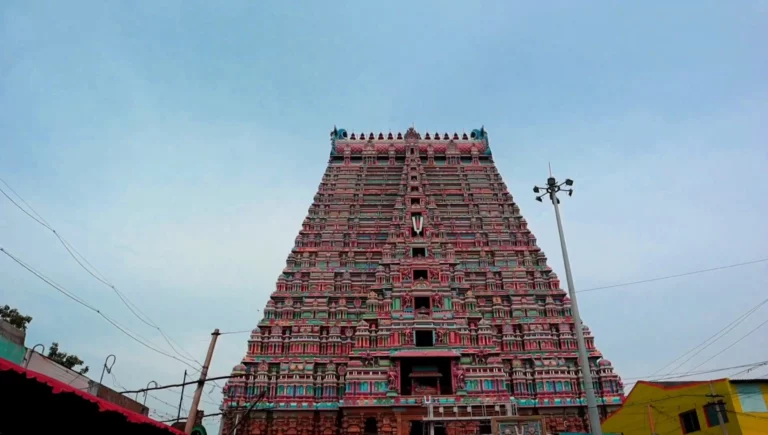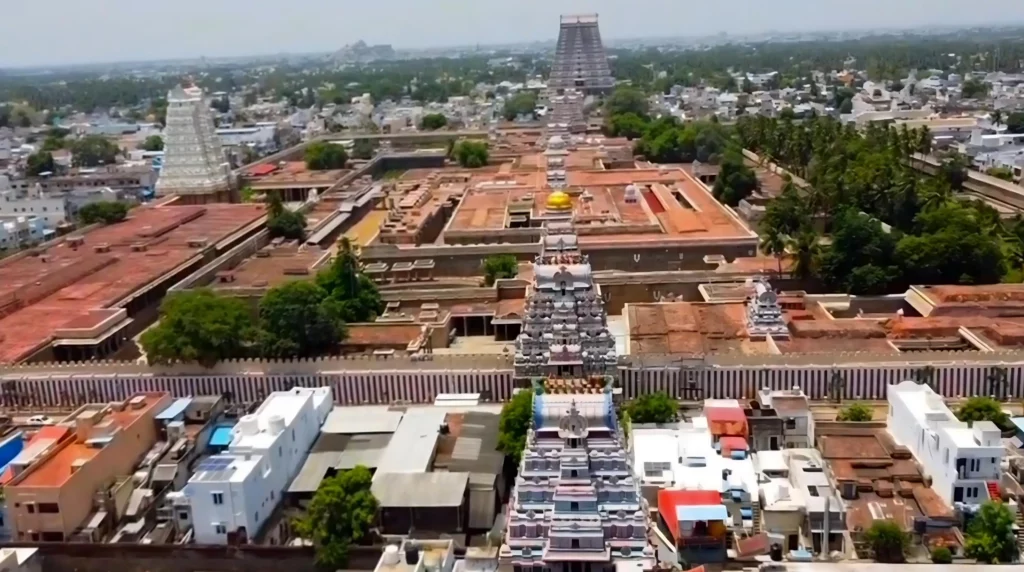Trichy Srirangam Temple

Lord Ranganathaswamy Temple is the home of a deity known by the Tamil names Nam Perumal and Azahagiya Manavaalan, which translates to “our god” and “beautiful groom.” Lord Ranganatha is a reclining form of Lord Vishnu.
Regarded as one of the eight sywayambu kshetras of Lord Vishnu by Alwar, the poet-saints of Tamil Nadu, its magnificence has made it the only temple that has received acclaim from all of them in their hymns. They composed up to 247 pasurams, or songs, in unison honouring the temple and its chief god.
Spread on 155 acres, it is frequently referred to as the largest operational Hindu temple in the world. It is also the location of South India’s highest gopuram or temple tower. Indeed, the rajagopuram, rising in 11 ascending stages to 237 feet above the complex base, is a feat of architectural grandeur.
History
Here, guests can learn about the temple’s past, which some historians claim dates back to the third century B.C. According to some theories, the Gangas, a reigning dynasty with its capital at Talakkadu on the banks of the Kaveri, constructed it later in the ninth century A.D. Nevertheless, during the ensuing years, the temple grew to become a significant centre of both religion and culture.
Despite multiple invasions due to its strategic location on an island sandwiched between two rivers, it continued to be a major hub for the expanding Bhakti movement. Reconstructed in the late 14th century, it is now regarded as one of the world’s greatest Hindu temple complexes. Additionally, in the 16th, 17th, and 21st centuries, extensions were made to its initial construction.
Not only does the temple have ancient inscriptions in Tamil, but also in Sanskrit, Telegu, Marathi, Oriya, and Kannada, indicating the diversity and exchange of cultures that prevailed during its early history. The scripts utilized for these inscriptions include Tamil and Grantha, which have been utilized since the sixth century A.D. by scholars from Tamil and Malayalam to write Sanskrit.
Architecture
The Srirangam Temple is worth seeing for its magnificent architecture in addition to its religious and cultural significance. The complex, which houses the biggest operational Hindu temple globally, is fashioned in the traditional Dravidian architectural style.

Its seven prakarams, or compounds, signify the seven chakras connected to our body and soul, and it spans 155 acres. There are 81 shrines, 21 magnificent gopurams, and 39 opulent pavilions within the compound area. The complex, which was built in stone and features intricate carvings, contains over 800 inscriptions that shed light on the social and theological influences that shaped mediaeval society. There are also frescoes in the complex that portray episodes from religious teachers’ lives as well as those from Hindu texts and mythology.
The Hall of 1000 Pillars is one of the temple complex’s most notable architectural features. Constructed around the 13th and 15th centuries, this granite construction boasts a central water tank and a mandapam (hall). Particular attention should be paid to the eight massive pillars that display amazing sculptures of soldiers in motion.
Deities
In the innermost sanctum of the temple, visitors can worship Lord Ranganatha up close. On Adisesha, the five-hooded, coiled serpent, lies back in a reclined position. His idol’s use of stucco and thailam, a paste composed of musk, camphor, honey, jaggery, and sandal, gives it a distinctive quality.
His sanctuary is designed to resemble the Tamil word Om and is embellished with a gold-plated vimanam, or crown tower. On its gable are images of the 11th-century Hindu philosopher Ramanuja and Paravasudeva, also known as the Supreme Being.
Every one of the 81 shrines in the temple complex offers devotees the chance to receive a darshan of another deity. These include saints who are Alwar or Bhakthi poets, religious experts, and numerous manifestations of Lord Vishnu and Goddess Lakshmi. These include Gopala Krishna, Narasimha, Rama, Hayagreeva, Sridevi, Bhudevi, Alagiyamanavalan, and Chakkarathazhwar.
Special Features
Special features that serve as excellent models of civic amenities for both residents and visitors can still be found throughout the vast complex. Granaries and water tanks are a couple of these. Additionally, it is the location of several temple chariots, which are essential for festivals and other special events.
A guest’s schedule should include a special mention for the Surya soc, named after the sun, and the Chandra pushkarani, named after the moon, among the temple’s twelve principal water tanks. These two water tanks have a combined capacity of two million litres. Several granaries are also located within the property. This guarantees that the temple kitchen is adequately stocked to cater to both the local populace and guests, including the less fortunate.
A number of the most important temple chariots in the compound include the Garuda, Simha, Hanumantha, and Sesha vahanas. This is particularly significant during holidays and special events.
Festivals
There are numerous festivities held in the temple all year round.
When making travel plans, guests might want to keep these in mind.
- Sri Jayanthi: During the festival, all the incarnations of Lord Vishnu who live in the temple complex celebrate their birthdays. With 81 temples, most of which are devoted to Lord Vishnu, the temple complex truly comes alive during the festival, complete with unique ceremonies and processions.
- Ekadesi: This 21-day celebration comes throughout the Tamil calendar month of Margazhi, which is January or December. On the major day, thousands of devotees and tourists watch as Lord Ranganatha Swamy emerges from his sanctum and takes part in a magnificent parade. On this day, he assumes the role of a king and is called Sri Ranganathar. In the magnificent Hall of 1000 Pillars, he has a divine court for the whole day, with elaborate decorations, bhajans, and countless ceremonies honouring his splendour.
- Chithirai Ther: A celebration that dates back to the 13th century, it honours the restoration of the temple made possible by a Vijayanagara king’s donation of 17,000 gold pieces. This came after foreign rulers had invaded and neglected it. It’s a nine-day celebration that falls between March and April, the Tamil calendar’s Panguni month. Known by another name, Brahmotsavam, visitors may anticipate seeing large processions, crowds, and a great deal of passion throughout this time.
- Ratothsavam: The yearly temple chariot festival, known as Ratothsavam, is another significant event that visitors should not miss. Lord Utsavar is driven throughout the temple compound in a special temple chariot during this celebration, which takes place between January and February to correspond with the Thai month according to the Tamil calendar. When making travel plans, take into account additional celebrations including Kaisiga Ekadesi, Oonjal, Vasanthothsavam, Pavithrothsavam, and Chitra Poornima.
PM Modi’s visit to Tamil Nadu
Before Prime Minister Narendra Modi’s visit to the Trichy Srirangam Sri Ranganathasamy Temple on January 20, the district administration of Trichy has banned the use of drones, according to an official statement released on Wednesday. In Trichy City, using drones is prohibited from January 17 to January 20. The statement stated that Pradeep Kumar, the district collector of Trichy, had also threatened to take harsh measures against anyone seen flying drones and other things while the prime minister was there.
According to a statement released on Wednesday, Prime Minister Narendra Modi will visit Maharashtra, Karnataka, and Tamil Nadu on January 19 and inaugurate several development projects in the three states.
During his two-day visit to Kerala, Prime Minister Modi prayed for the happiness and prosperity of the nation’s residents on Wednesday at the Sreekrishna Temple in Guruvayur. Primate Modi dressed traditionally in a’mundu’ (dhoti) and’veshti’ (shawl covering the upper body) while praying at the temple, following the convention for him to wear native clothing when visiting various states.
Contact Details
Address:
Sri Ranganathar Swamy Temple,
Srirangam, Tiruchirappalli – 620 006.
Tamil Nadu, India.
Phone: +91 431 2432246
Email: srirangam@tnhrce.com
Email: srirangamtemple@gmail.com
Yatri Nivas: +91 9486482246
FAQs
When is the Viswaroopa seva held at Srirangam Temple?
Every day, from 6 am to 7:15 am, Viswaroopa seva is conducted.
What is the special entrance fee at Srirangam Temple?
There is a special entrance fee of INR 10 per person for devotees.
Are these times set in stone or are they flexible?
Although the times for pooja and seva are set every day, they may vary on festival days or other special occasions.
Do devotees have access to any lodging options?
The Temple guesthouses, which are located close to the main temple gate, provide lodging for devotees.
What major festivals are celebrated at Srirangam Temple?
Vasanthotsavam, Rathotsavam, Brahmotsavam, Jyestabisheka, and Vaikunta Ekadashi are a few of the unique occasions that are observed in Srirangam Temple.